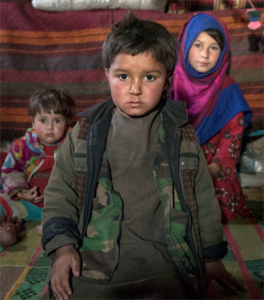Afghanistan on the brink of economic collapse – UN
Conflict and insecurity, drought, COVID-19 and an economy in freefall are driving increased levels of poverty and pushing Afghanistan to the brink of collapse, according to the United Nations.
The Director General of the UN’s International Organisation for Migration Antonio Viterino says that he is concerned for the future as ae bitter winter approaches.
 “There is a real risk that the deteriorating humanitarian situation will result in increased displacement, vulnerability and suffering, and that the modest social and development gains of the past two decades will be lost,” Mr Viterino said after a two-day visit to the beleaguered nation.
“There is a real risk that the deteriorating humanitarian situation will result in increased displacement, vulnerability and suffering, and that the modest social and development gains of the past two decades will be lost,” Mr Viterino said after a two-day visit to the beleaguered nation.
Five and a half million people are internally displaced – roughly the population of Finland – including more than 670,000 forced to leave their homes so far this year, 60 per cent of whom are children.
And the UN says aid and support is needed for mobile populations, including internally displaced people, returnees and under-served host communities.
More than half the population, or nearly 19 million people, are struggling to eat, malnutrition is reaching dramatic levels, especially for many children, and more than 80 per cent of the people surveyed by the UN say they have lost their jobs and livelihoods. Millions are living in inadequate shelters with limited access to basic services, including sanitation and health care, the UN says.
The number of people without enough food to eat is set to rise to nearly 23 million by the end of the year.
And what started as a drought crisis has spiralled into economic disaster, with nine in 10 major urban centres also expected to face extreme hardship, as debts pile up and savings dwindle.
And the already widespread drought looks set to worsen, as farmers and herders brace for a likely second consecutive year of drought in 2022, with La Niña expected to bring drier than normal conditions to Afghanistan in the coming months.
This situation will create a very real famine risk in 2022, unless immediate large-scale support to protect these people and their livelihoods arrives very soon, the Food and Agriculture organisation has warned.
Increasing numbers of people returning to the country in recent have compounded the challenges.
More than a million Afghans have returned from Iran and Pakistan this year, while others are trying to leave the country.
The majority were deported, returning to Afghanistan often with little money, in need of health care, food and rest.
The UN says the task of reuniting these with family and reintegrating into communities – especially for those who have been in Iran or Pakistan for years – is difficult considering the high levels of unemployment and food insecurity.
Climate change has also had an impact in Afghanistan, contributing to internal displacement. The UN estimates that around 70 per cent of the population has been impacted by drought and flooding and crop failures.
Mr Viterino said an economic collapse would be devastating for the nation and the current aid effort was a race against time winter approaches.
“We are going “door to door” to see what is needed and are providing shelter, blankets, warm clothing, and cash for fuel and heating. We are planning to expand winterization assistance to every province in the country to reach 200,000 people in need,” he said.
“I am convinced that inclusive, comprehensive measures are the best way to protect and promote livelihoods – especially those of Afghan women – and to ensure access to essential services for conflict-affected communities across the country.
“While international action intensifies to meet urgent humanitarian needs, I believe it also critical to support sustainable livelihoods, and work with the Afghan people to reduce their risk and vulnerability to climate change, conflict and further disasters as we have been doing for decades.
“This can be done through targeted initiatives to promote resilience and adaptability. IOM is already implementing risk reduction, transition and early recovery programmes across Afghanistan, including critical infrastructure works to protect communities from floods, and to bolster the productivity of farmlands.
“Most importantly, all interventions, aid and support must embrace and empower the women and girls who are indispensable to the future of Afghanistan. The country will struggle to attain peace, stability and development without their active inclusion and contributions.
“The entire Afghan population, including women, men, boys and girls across all ethnic groups, must remain fully represented and able to participate meaningfully in the daily life of their communities and country,” Mr Viterino said.
He said it would take the “sustained attention and generosity of the global community to harness the strength of the people and avoid a humanitarian catastrophe the fallout from which could reverberate across regions and generations”.












